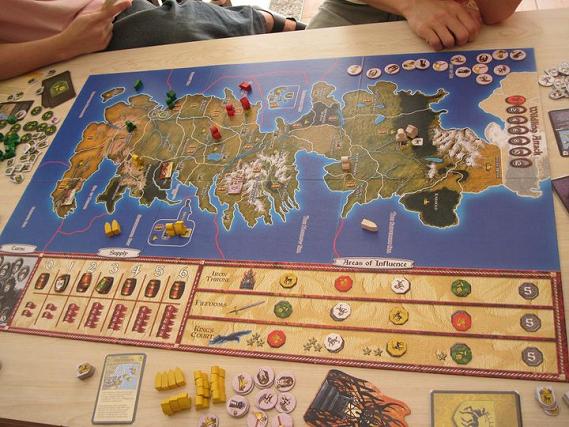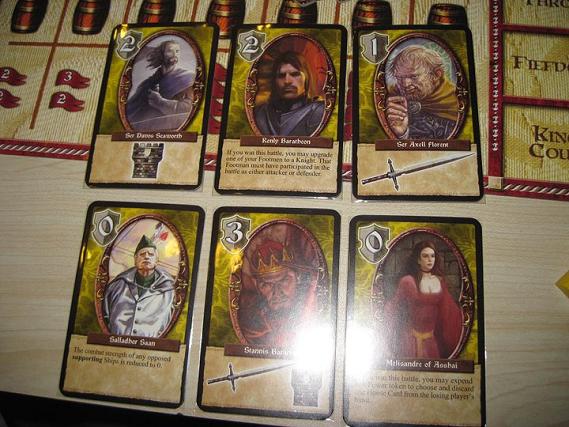
Since Shan and I are leaving Kota Kinabalu soon, I guess I ought to make a more determined effort to play those games in Sean’s collection that I’m interested in. As a reader of the book series and a fan of George R.R. Martin since I discovered the Wild Cards anthologies back in high school, I would certainly count the Game of Thrones boardgame in that category. This one is a wargame recreating the War of the Five Kings depicted in the series. As we only had four players, House Greyjoy was omitted as per the rules and so Chee Wee controlled the Starks, Shan controlled the Lannisters, Sean had the Tyrells and I had the Baratheons.
The object of the game is to be the first to control seven cities or strongholds. Unfortunately, we got some critical rules wrong so our experience probably wasn’t what the designers intended. Still, I felt that Chee Wee’s win was legitimate, considering how aggressively he moved and how slowly the rest of us moved to stop him. The game is old enough that I’m not going to describe the rules in detail, so here’s a summary of the salient points:
- Most wargames have a specific phase in each round where players can purchase troops. In A Game of Thrones however, this is a random event depending on cards drawn at the beginning of each turn. Controlling more cities and strongholds gives you more Muster Points which you can spend on troops, but only when the Muster event comes up so you can’t count on reinforcements appearing at a specific time. Similarly, supply icons on the territories you control determines your position on the Supply Track, which in turn caps how many armies you may have at one time and the size of each army, but the track is only updated when the appropriate event card pops up, so even if you’ve conquered new territories with supply iconsm you don’t get the benefit immediately.

- The primary gameplay mechanic is placing order tokens face down on the board in territories where you have units in and then uncovering them simultaneously. There are tokens for movement/attack, supporting friendly adjacent troops, consolidating power which is equivalent to gathering resources from the land, defending where you expect an attack to arrive and one interesting order, raiding which allows you to remove adjacent enemy order tokens, provided that they’re support, consolidate power or another raid. Each player has three of each token type though one of each group has a star on it, meaning that you need sufficient stars on the King’s Court track to use them.
- Combat is deterministic without the use of dice. There are only two types of units on land, footmen with a combat strength of 1 and knights with a strength of 2. At sea, each boat has a strength of 1. Each side adds his total together, modifies it by the strength of supporting units in adjacent territories if available and applies bonuses for the attack, defense and support order tokens they played. Then each player simultaneously plays reveals a House Card which gives an additional bonus from 0 to 3. The player with the highest strength wins the battle. The loser must then retreat his troops.
- Interestingly, combat rarely involves casualties. Some of the House Cards have swords and/or tower icons. The winner of each battle inflicts casualties on the loser equal to the number of sword icons he has, minus the tower icons of the defender. Most of the time there are no casualties at all and even when there are, only one unit dies. It’s novel but I’m not sure what I feel about that. It makes combat feel almost inconsequential as if an attack fails, you can just try again later.

- The political intrigue that plays such an important part in the books is abstracted in the form of bidding for position along three tracks. The Iron Throne track determines turn order and breaks ties in all forms of non-combat conflict. The Fiefdoms tracks breaks ties in combat. The King’s Court track determines how many order tokens with stars each player may play. I think it’s a pretty poor representation of the political maneuvering that takes place in the novels but I suppose it’s better than nothing.
And here are my thoughts on our session and the game’s design itself:
- Chee Wee led the game throughout and won handily. He had the entire north all to himself, leaving his entire hinterland undefended to attack the south. The rest of us were packed more closely together and were afraid to move too boldly in fears of leaving ourselves open to attack. I could have taken King’s Landing quite easily with a land army and a fleet in support, but that would have allowed Chee Wee’s ships to come further southwards and I didn’t want to paint a target on myself. As always, it pays to be bold in such games.
- Sean messed up majorly as he was the only one in position to stop Chee Wee by using boats to bypass the bottleneck in the middle of the continent and strike directly at Winterfell. Shan bore of the brunt of Chee Wee’s early attacks and probably played her House Cards inefficiently, wasting her 3 value card when she had little chance of success. Towards the end of the game, I realized that Chee Wee only needed to take one of my cities to win and brought everything there to defend. I repulsed one attack but then he brought another army to bear and he beat me by just one point.

- I feel it’s an okay wargame but it doesn’t offer anything really special. I also feel that it doesn’t really fit the Song of Ice and Fire theme. The wildings’ attack is too artificial and everyone risks losses due to it, even if their holdings are nowhere near the wall. In the books, none of the Five Kings except Stannis Baratheon did anything about it either. Heck, I don’t think they even knew there was an attack. The rich characters of the books only show up in the form of the House Cards instead figures that you can push around the map. It’s just not very satisfying. And why is Eddard Stark even a card? It’s not like he played any role in the War of the Five Kings.
So I’d say it feels more like a generic wargame cashing in on the license than a faithful labor of love like War of the Ring. It’s not a bad game on its own merits but I’m disappointed that it doesn’t feel much like A Game of Thrones after all.
One Response to “A Game of Thrones”
I ended up with three copies of this game for Christmas. I guess my family and friends know I’m a Song of Ice and Fire fan. I’m also a pretty experienced gamer and roll player, so I wasn’t daunted diving into this with some gaming friends. Though it looks intimidating at first, we were surprised by how simple game play is. Each round goes quickly once you get the hang of it.
The part I really like which distinguishes it from many other strategy or resource based games is that there are so many areas to choose to focus on. The section of the board called the “Influence Tracks” ranks your dominance in three areas. You can control the Iron Throne, giving you the ability to break ties and take your turn first. Your position in the Fiefdom track gives you an advantage in battle. Or you can control the King’s Court, allowing you advantages in sending orders and obtaining information. Another area called the Supply track controls the number of armies you can have in play. Like the books, these Influence and Supply Tracks gave the game levels upon levels of strategy.
The game itself is beautiful and well made. Though the credits list many artists, I recognized that some of the house cards feature artwork from the 2009 calendar by Michael Komarck. I thought the house cards were a creative way to include the individual characters from the book into game play.
Overall, very fun. I wish I had more opportunities to play because I haven’t won yet. 🙂
Have a nice day,
Fane @
Leave a Reply